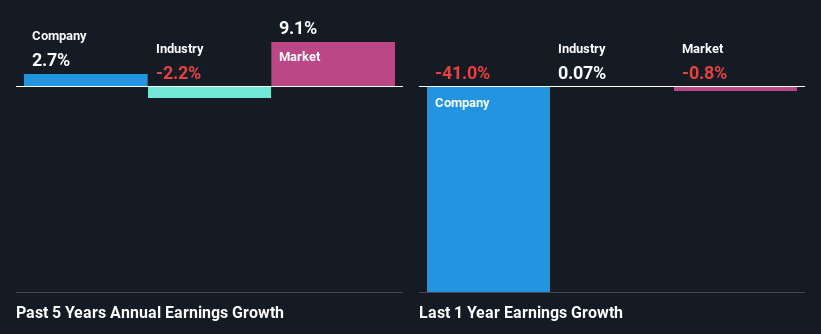Is Vivo Energy plc's (LON:VVO) Latest Stock Performance A Reflection Of Its Financial Health?
Vivo Energy (LON:VVO) has had a great run on the share market with its stock up by a significant 12% over the last three months. Since the market usually pay for a company’s long-term fundamentals, we decided to study the company’s key performance indicators to see if they could be influencing the market. Specifically, we decided to study Vivo Energy's ROE in this article.
Return on Equity or ROE is a test of how effectively a company is growing its value and managing investors’ money. In short, ROE shows the profit each dollar generates with respect to its shareholder investments.
View our latest analysis for Vivo Energy
How Do You Calculate Return On Equity?
ROE can be calculated by using the formula:
Return on Equity = Net Profit (from continuing operations) ÷ Shareholders' Equity
So, based on the above formula, the ROE for Vivo Energy is:
11% = US$90m ÷ US$812m (Based on the trailing twelve months to December 2020).
The 'return' is the profit over the last twelve months. Another way to think of that is that for every £1 worth of equity, the company was able to earn £0.11 in profit.
Why Is ROE Important For Earnings Growth?
So far, we've learned that ROE is a measure of a company's profitability. Depending on how much of these profits the company reinvests or "retains", and how effectively it does so, we are then able to assess a company’s earnings growth potential. Generally speaking, other things being equal, firms with a high return on equity and profit retention, have a higher growth rate than firms that don’t share these attributes.
Vivo Energy's Earnings Growth And 11% ROE
At first glance, Vivo Energy seems to have a decent ROE. Further, the company's ROE is similar to the industry average of 11%. Vivo Energy's decent returns aren't reflected in Vivo Energy'smediocre five year net income growth average of 2.7%. We reckon that a low growth, when returns are moderate could be the result of certain circumstances like low earnings retention or poor allocation of capital.
When you consider the fact that the industry earnings have shrunk at a rate of 2.2% in the same period, the company's net income growth is pretty remarkable.
Earnings growth is an important metric to consider when valuing a stock. The investor should try to establish if the expected growth or decline in earnings, whichever the case may be, is priced in. By doing so, they will have an idea if the stock is headed into clear blue waters or if swampy waters await. Has the market priced in the future outlook for VVO? You can find out in our latest intrinsic value infographic research report.
Is Vivo Energy Using Its Retained Earnings Effectively?
A low three-year median payout ratio of 10% (implying that the company retains the remaining 90% of its income) suggests that Vivo Energy is retaining most of its profits. However, the low earnings growth number doesn't reflect this fact. So there might be other factors at play here which could potentially be hampering growth. For example, the business has faced some headwinds.
In addition, Vivo Energy has been paying dividends over a period of three years suggesting that keeping up dividend payments is way more important to the management even if it comes at the cost of business growth. Upon studying the latest analysts' consensus data, we found that the company's future payout ratio is expected to rise to 47% over the next three years. However, Vivo Energy's future ROE is expected to rise to 18% despite the expected increase in the company's payout ratio. We infer that there could be other factors that could be driving the anticipated growth in the company's ROE.
Summary
Overall, we are quite pleased with Vivo Energy's performance. Specifically, we like that the company is reinvesting a huge chunk of its profits at a high rate of return. This of course has caused the company to see substantial growth in its earnings. With that said, the latest industry analyst forecasts reveal that the company's earnings are expected to accelerate. To know more about the company's future earnings growth forecasts take a look at this free report on analyst forecasts for the company to find out more.
This article by Simply Wall St is general in nature. It does not constitute a recommendation to buy or sell any stock, and does not take account of your objectives, or your financial situation. We aim to bring you long-term focused analysis driven by fundamental data. Note that our analysis may not factor in the latest price-sensitive company announcements or qualitative material. Simply Wall St has no position in any stocks mentioned.
Have feedback on this article? Concerned about the content? Get in touch with us directly. Alternatively, email editorial-team (at) simplywallst.com.

 Yahoo Finance
Yahoo Finance 
